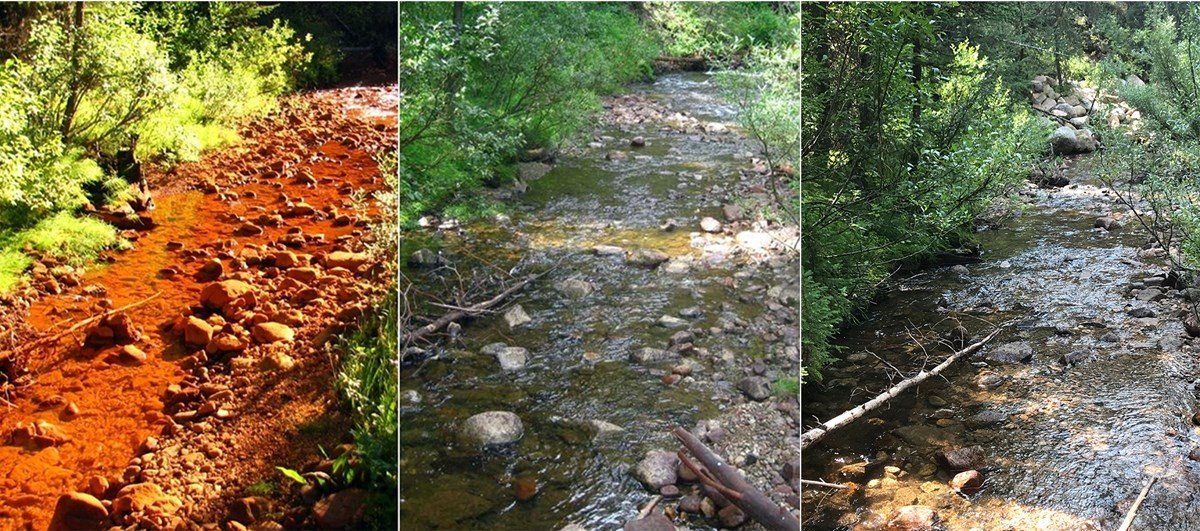Yellowstone creek finally recovers from toxic mining residue
Soda Butte Creek, one of the few streams that flows through Yellowstone National Park from the Beartooth Mountains, was recently removed from the list of Montana’s Impaired Waters. The creek's recovery is the first abandoned mine lands project to achieve this ground-breaking milestone. For more than 80 years, waste rock and tailings residue from the McLaren mine site leached heavy metals into Soda Butte Creek, which was considered the most polluted stream threatening any national park. “Restoring Soda Butte Creek was a national priority, and rightfully so,” said Yellowstone National Park Superintendent Cam Sholly during a celebration of the delisting on July 18, 2019.
Forest Service employee Mary Beth Marks speaks at the former McLaren mining site on the July 18th tour. (Photo GYC/Joe Josephson.)
Greater Yellowstone Coalition and the Beartooth Alliance lead the effort that stopped proposals to reopen and significantly expand the mining district in 1996. A mineral withdrawal signed by President Clinton and permanent legislation spearheaded by Montana Senator Max Baucus followed. These events set the stage for cleanup and a final settlement with Crown Butte Mining included $22.5 million for reclamation. Between 1998 and 2017, the Forest Service spent $2.5 million on restoration and $8 million in funding from the Land and Water Conservation Fund (LWCF) went towards purchasing priority mining in-holdings, protecting the land from further mining.
In honor of Soda Butte Creek's removal from the Impaired Waters list, Autumn Coleman of the Montana Department of Environmental Quality (DEQ) led nearly 100 people on a tour of the McLaren mill site, tailings, and new repository. GYC staff were there, and standing next to the creek, we could only imagine the environmental challenge presented by the mining residue with the consistency of "creamy peanut butter" that once rose 35 feet above our heads.
Soda Butte Creek downstream of the McLaren tailings impoundment in 2008 shows contamination by orange-colored iron (left) that is not evident in 2013 and 2018 (center and right, respectively) following the cleanup. (Photo National Park Service
For years, copper and iron levels in Soda Butte Creek exceeded water quality standards by over 1000 times allowable limits and dangerous lead levels by more than 100 times. Fish could not be kept alive in the waters of Soda Butte Creek for more than 24 hours. In an ironic twist of fate, this chemical barrier created by the McLaren site kept introduced brook trout from reaching and destroying the imperiled Yellowstone cutthroat populations inside the park. Today, native trout are finding their way back into upper Soda Butte Creek while healthy and diverse invertebrate populations are thriving throughout the once-dead zone.
We are grateful of the Beartooth Alliance and their continued diligence and leadership over the years for the restoration of these headwaters. While delisting Soda Butte Creek is the crowning success, cleanup of the McLaren site and the New World Mining District entailed a complex “response and restoration project” to address 65 acres across 40 square miles at elevations up to 10,400 feet. In the end, 85 abandoned mines were reclaimed and nearly 180,000 cubic yards of toxic waste was removed - with more than 400,000 tons from Soda Butte Creek alone. The McLaren open-pit mine at the headwaters of the Stillwater River was consolidated, covered with a liner more than ten football fields in size, and restored. A major acid producer, the Glengarry Adit site, was plugged when the mill site was restored. The districts’ most dangerous human health hazard of high arsenic and lead levels site was reclaimed.
Montana’s Department of Environmental Quality employee Autumn Coleman gives a talk about the toxic residue from the McLaren mill site. (Photo GYC/Joe Josephson.)
GYC staffers Bob Zimmer, Jennifer Drinkwalter, and myself attended the Soda Butte Creek celebration. Custer Gallatin Forest team leader Mary Beth Marks led participants on a tour of both the McLaren Pit and the Glengarry Adit mining site. During Cycle Greater Yellowstone’s stop in Cooke City on August 13 and 14, Forest Service and DEQ employees will be on hand to give evening round table discussions on this topic as well as tours of the New World Mining District.
—Joe Josephson, Senior Montana Conservation Associate



